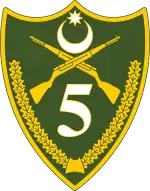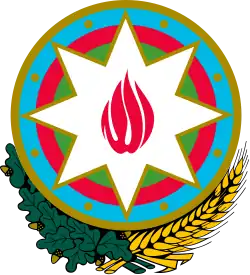Azerbaijani Land Forces
The Azerbaijani Land Forces (Azerbaijani: Azərbaycan Silahlı Qüvvələri Quru Qoşunları) are the land force component of the Azerbaijani Armed Forces.[2][3] Since the fall of the Soviet Union, Azerbaijan has been trying to create professional, well trained, and mobile armed forces. Based on 2013 statistics, the country has about 56,850 ground force troops, with additional paramilitary forces of 15,000. In addition, there are 300,000 former service personnel who have had military service in the last fifteen years.[1]
| Azerbaijan Land Forces | |
|---|---|
| Azərbaycan Silahlı Qüvvələri Quru Qoşunları | |
 Flag of Azerbaijan Land Forces | |
| Active | c.1992 - present |
| Country | |
| Allegiance | Azerbaijan |
| Branch | Land Forces |
| Size | IISS 2013: 56,850[1] |
| Part of | Azerbaijan Armed Forces |
| Headquarters | Baku |
| March | "Forward" (Marş "İrəli") |
| Engagements | |
| Commanders | |
| Notable commanders | Samad bey Mehmandarov |
| Insignia | |
| Badge of the Azerbaijani Land Forces |  |
Reportedly, in wartime, the Army proper could call upon the support of the National Guard, the Internal Troops of Azerbaijan, and the State Border Service. The exact wartime command structure remains unclear.
History
During the Soviet period, Azerbaijan was part of the Transcaucasus Military District, whose forces in the republic were commanded by the 4th Army. The 4th Army consisted of three motor rifle divisions (the 23rd Guards Motor Rifle Division (MRD) at Ganja, the 60th Motor Rifle Division at Lankaran, and the 295th Motor Rifle Division in Baku) and army troops that included missile and air defense brigades and artillery and rocket regiments. Azerbaijan also hosted the 49th Arsenal of the Main Agency of Missiles and Artillery of the Ministry of Defense of the Russian Federation, which contained over 7,000 train-car loads of ammunition to the excess of one billion units. In addition, the 75th Motor Rifle Division, part of the 7th Guards Army, was in the Nakhichevan Autonomous Republic.
In summer 1992, the Defense Ministry of Azerbaijan, following a resolution by the Azerbaijani president on the privatization of units and formations in Azerbaijani territory, forwarded an ultimatum demanding control over vehicles and armaments of the 135th and 139th motorized rifle regiments of the 295th Motor Rifle Division.[4] The transfer of the property of the 4th Army (except for over half the equipment of the 366th Guards Motor Rifle Regiment of the 23rd Division captured by Armenian armed formations in 1992 during the regiment's withdrawal from Stepanakert) and the 49th Arsenal was completed in 1992. Thus, by the end of 1992, the Azerbaijani Government received arms and military hardware sufficient for approximately three motor rifle divisions with prescribed army units. The stores and equipment of the 75th Division were handed over to the Nakhichevan government.[5] The former Division HQs may have contributed to the formation of corps headquarters.
Azerbaijan also reorganized its army. Over the last 15 years, Azerbaijan has been preparing its armed forces for possible action against Armenian forces in Nagorno-Karabakh. Intermittent fighting continued, most recently breaking out into the 2020 Nagorno-Karabakh conflict.
Azerbaijan has contracted with Turkey for troop training to strengthen its armed forces. This is necessary in view of deficiencies that Jane's World Armies said in 2004 included huge problems in training, equipping and motivating its soldiers; corruption in its ranks; and a highly politicized officer corps.[6] The Soviet Army tradition of dedovshchina, institutionalized hazing, appears to be continuing in the armed forces as of 2008.[7] The quality and readiness of much of the army's equipment, Jane's said, is also a problem, as a decade of poor maintenance and chronic shortages of spare parts means that many systems are not operational, or cannibalised for parts. Azerbaijan has the second highest military expenditure in CIS. Azerbaijan's defense spending is second only to Russia's within the Commonwealth of Independent States. [8]
Structure

Faced by Armenian forces, the Azeri military was forced back out of Nagorno-Karabakh, and was significantly reorganised in the mid-1990s predominantly around brigades, though at least one division was reported as late as 2000. Maneuver formations have consistently stayed at a strength of around twenty brigades and regiments since 1995, though that has slowly risen recently. During the 1990s, these brigades may have included the 701st Motor Rifle Brigade (1st Army Corps), the 708th Motor Rifle Brigade (1st Army Corps), 130th Motor Rifle Brigade (1st Army Corps), 161st Motor Rifle Brigade (2nd Army Corps), 709th Motor Rifle Brigade (formerly the 23rd Motor Rifle Division), and the 112th Motor Rifle Brigade.
The Land Forces currently consist of five army corps:[9]
 1st Army Corps also known as Barda Army Corps (deployed near Ganja ), currently led by Major General Hikmat Hasanov
1st Army Corps also known as Barda Army Corps (deployed near Ganja ), currently led by Major General Hikmat Hasanov
- 1st Motor Rifle Brigade
- 3rd Motor Rifle Brigade
- 9th Motor Rifle Brigade
- 10th Motor Rifle Brigade
- 15th Motor Rifle Brigade
- 17th Motor Rifle Brigade
 2nd Army Corps also known as Beylagan Army Corps (concentrated against Armenian occupied territories and part is deployed on the Azerbaijan-Iranian border), currently led by Major General Mais Barkhudarov[10]
2nd Army Corps also known as Beylagan Army Corps (concentrated against Armenian occupied territories and part is deployed on the Azerbaijan-Iranian border), currently led by Major General Mais Barkhudarov[10]
- 2nd Motor Rifle Brigade
- 4th Motor Rifle Brigade
- 6th Motor Rifle Brigade
- 8th Motor Rifle Brigade
- 13th Motor Rifle Brigade
- 14th Motor Rifle Brigade
- 18th Motor Rifle Brigade
 3rd Army Corps also known as Shamkir Army Corps (concentrated against Armenian occupied territories), currently led by Lieutenant General Rovshan Akbarov[11][12][13]
3rd Army Corps also known as Shamkir Army Corps (concentrated against Armenian occupied territories), currently led by Lieutenant General Rovshan Akbarov[11][12][13]
- 7th Motor Rifle Brigade
- 11th Motor Rifle Brigade
- 12th Motor Rifle Brigade
- 16th Motor Rifle Brigade
- 19th Motor Rifle Brigade
- 20th Motor Rifle Brigade
 4th Army Corps also known as Baku Army Corps (covers Absheron Peninsula and the coast)
4th Army Corps also known as Baku Army Corps (covers Absheron Peninsula and the coast)
- Motor Rifle Brigade
- Motor Rifle Brigade
- Motor Rifle Brigade
 Nakhchivan Separate Combined Arms Army (deployed in Nakhichevan ), currently led by Colonel General Karam Mustafayev[14]
Nakhchivan Separate Combined Arms Army (deployed in Nakhichevan ), currently led by Colonel General Karam Mustafayev[14]- 6th Army Corps
The IISS estimated in 2007 that the Azeri regular army was 56,840 strong, probably basing this figure on Conventional Forces in Europe treaty data. It attributes to the army five corps headquarters, 23 motor rifle brigades, one artillery brigade, one multiple rocket launcher brigade, and one anti-tank regiment.[15] Of the five army corps, the 1st, 2nd, and 3rd Army Corps are concentrated against NK; part of 2nd is deployed on the Azerbaijan-Iranian border; the 4th covers the capital and the coast and the 5th is deployed exclusively in Nakhichevan.[16][17] Following the 2020 war, and specifically during the Baku Victory Parade, experts noted that a 6th corps was created, in part due to the partial mobilization that occurred in the country during that 44-day period.[18][19]
In addition, the Army maintains the following units:
 Azerbaijani Special Forces
Azerbaijani Special Forces- Peacekeeping Battalion
- Security Team
- Artillery Brigade
- Multiple Rocket Launcher Brigade
- Anti-Tank Regiment
- Communication Brigade
- Engineering Brigade
- Logistics Brigade
Ranks
Officers
|
Warrant OfficersNCOs and Enlisted
|
Service March
The service march of the Lane Forces is "Forward" (Marş "İrəli") also known as the "Soldier's Anthem" (Əsgər Marşı). The lyrics are based on that of the Regiment March, which is the official march of the Special Forces Command of Turkey. The lyrics of the march are as follows:[21]
|
The march was written by Cavanşir Quliyev.[22] It is performed at all military parades in Azerbaijan.
See also
References
- The Military Balance 2013. London: Routledge for the IISS. 2013. p. 216. ISBN 978-1-85743-680-8.
- Azərbaycan Quru Qoşunları yaradıld Archived 6 July 2011 at the Wayback Machine (in Azerbaijani)
- В Азербайджане созданы сухопутные войска Archived 19 July 2011 at the Wayback Machine (in Russian)
- Vladimir Petrov, How South Caucasus was armed Archived 24 October 2007 at the Wayback Machine, Centre for Analysis of Strategies and Technologies (Moscow, Russia)
- Tehran IRNA, 9 January 1992, as transcribed in FBIS, Soviet Union Daily Report, 92-007, 10 January 1992, p. 53., via ref in 75 MRD note in 7th Guards Army article.
- Jane's World Armies Azerbaijan, as accessed October 2004.
- "Infosud - Tribune des Droits Humains | www.infosud.org Journal en ligne offrant une information indépendante et pluraliste sur les droits de l'homme dans le monde". Humanrights-geneva.info. Archived from the original on 13 November 2008. Retrieved 7 March 2010.
- "Azerbaijan has second highest military expenditure in CIS". News.Az. Archived from the original on 26 February 2011. Retrieved 22 February 2011.
- C. W. Blandy Azerbaijan: Is War Over Nagornyy Karabakh a Realistic Option? Advanced Research and Assessment Group. Caucasus Series 08/17. — Defence Academy of the United Kingdom, 2008, p.12 Archived 10 May 2011 at the Wayback Machine
- "Провал военной хунты". Free Azerbaijan (in Russian). 16 November 2020. Archived from the original on 22 January 2021. Retrieved 5 December 2020.
- Netservice.az. "General-leytenant Əkbərov - 50-ni haqladı - VİDEO". ATV.AZ (in Azerbaijani). Archived from the original on 22 January 2021. Retrieved 26 November 2020.
- "Rövşən Əkbərov Telman oğlu". Ens.az - 4 dildə xəbərlər və ensiklopediya (in Azerbaijani). Archived from the original on 4 February 2021. Retrieved 26 November 2020.
- "ƏKBƏROV RÖVŞƏN TELMAN OĞLU". VƏTƏN UĞRUNDA - Hərbi-Vətənpərvərlik Şurasının İnternet Orqanı (in Russian). Archived from the original on 4 February 2021. Retrieved 26 November 2020.
- "Vasif Talıbov Kərəm Mustafayevə general-polkovnik ali hərbi rütbəsini təqdim etdi". Azeri Defence (in Azerbaijani). 25 June 2020. Archived from the original on 4 February 2021. Retrieved 25 November 2020.
- IISS (2012). The Military Balance 2012. London: Routledge for the IISS. pp. 92–93.
- C. W. Blandy Azerbaijan: Is War Over Nagornyy Karabakh a Realistic Option? Advanced Research and Assessment Group. Caucasus Series 08/17. — Defence Academy of the United Kingdom, 2008, p.12 Archived 10 May 2011 at the Wayback Machine
- <"Archived copy". Archived from the original on 28 September 2011. Retrieved 6 April 2010.CS1 maint: archived copy as title (link)>
- "Azərbaycanda daha iki ordu korpusu yaradıldı". Gundelik-Baku.Com. Archived from the original on 4 February 2021. Retrieved 23 December 2020.
- Royal (11 December 2020). "Azərbaycanda daha iki Ordu Korpusu yaradıldı". Baku Press Klub (in Azerbaijani). Archived from the original on 4 February 2021. Retrieved 23 December 2020.
- "Azerbaijan". www.uniforminsignia.org. Archived from the original on 4 February 2021. Retrieved 25 November 2020.
- "Archived copy". Archived from the original on 4 February 2021. Retrieved 21 December 2020.CS1 maint: archived copy as title (link)
- "Archived copy". Archived from the original on 4 February 2021. Retrieved 21 December 2020.CS1 maint: archived copy as title (link)

